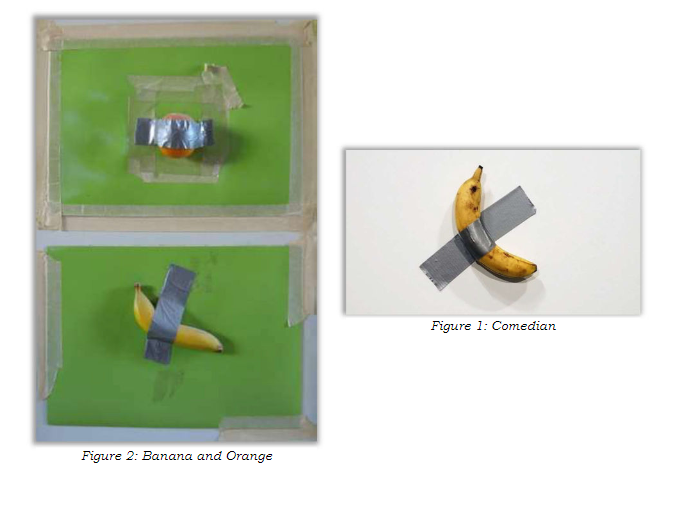How many ways are there to duct tape a banana to a wall? Apparently not too many. Earlier this week, Judge Scola in the Southern District of Florida found that the famous Art Basel banana--a sculpture consisting of a banana duct taped to the wall of Art Basel Miami--did not infringe Banana and Orange--another banana-duct-taped-to-wall sculpture.
Maurizio Cattelan is an Italian visual artist, known for America, a fully-functioning solid gold toilet that was once installed at the Guggenheim. In 2019, Cattelan created a piece called Comedian, in which he duct-taped a banana to a wall at Art Basel Miami. Cattelan claims that Comedian was conceived in response to Art Basel's call to present art at the 2019 fair, but was based on an earlier piece he did for New York Magazine that depicted a banana hanging from a billboard with red duct tape. It was meant to be simple and banal, and reflect absurdity.
But, lest you think Cattelan is the only person who would duct tape fruit to a wall, in 2001, California-based conceptual artist Joe Morford created Banana and Orange, which, as you might have guessed, consisted of a banana and an orange duct-taped to a wall. Images of both works, taken from the Court's decision, appear below with Morford's work on the viewer's left and Cattelan's on the right.

Cattelan's banana became big news. It appeared on the front page of the Post and two editions of the work sold for $120,000 each--apparently, complete with instructions on how to replace the banana should it pass its prime (or if you got a little hungry). Morford also took notice and sued Cattelan for copyright infringement.
Yesterday, and after previously having denied Cattelan's motion to dismiss, the Court granted summary judgment in Cattelan's favor, finding that Comedian did not infringe Banana and Orange. The Court dinged Morford on both access and substantial similarity. First, it noted that the "bare possibility of access" by its availability on the internet was insufficient to demonstrate that Cattelan had a "reasonable opportunity to view" the piece. For context, Morford's work had appeared in a YouTube video and been shared on Facebook and Blogspot, but Cattelan claimed in a declaration that he had never seen it and Morford presented no evidence to the contrary. Second, the Court, applying the abstraction-filtration-comparison test, found no substantial similarity between the two pieces. The test requires that a court first break the work down into its parts (abstraction), filter out any of those parts that are not protectible (filtration) and compare what remains (comparison). The Court found that the abstracted elements of Banana and Orange included two green panels attached to a wall, fruit centered on the panels, and, for the banana portion of the work in particular, a single piece of silver masking tape applied at an angle.
The Court then applied the merger doctrine, under which "expression is not protected in those instances where there is only one or so few ways of expressing an idea that protection of the expression would effectively accord protection to the idea itself." BellSouth Advert. & Publ'g Corp. v. Donnelley Info. Publ'g, Inc., 999 F.2d 1436, 1442 (11th Cir. 1993). Because there are only so many ways to tape a banana to a wall--and doing it with a single piece of tape at a non-parallel angle was, in the Court's opinion, the most obvious--the duct-taped banana gets filtered out. What remained of Morford's work after filtration were the green background, the orange--elements that do not appear in Comedian--along with the placement and angle of the banana--which the Court noted were different in the works. The only common element identified by the Court was that the banana's stalk was on the left-hand side of both sculptures, which alone was not sufficient to support substantial similarity.
The Court also found that Morford had failed to rebut Cattelan's evidence of independent creation. Morford had not submitted any evidence in response to Cattelan's declaration that the banana was a variation on his 2018 piece for New York Magazine and that he had never seen Banana and Orange.
This case was generally a little bananas, and the Court might have been better off making this same determination at the motion to dismiss stage. However, it provides interesting examples of the abstraction-filtration-comparison test and merger doctrine, and leaves us all safe to create our own banana-and-duct-tape work--a big win for aspiring fruit artists.

/Passle/5cb04e9a989b6e13ecfcf95d/SearchServiceImages/2026-01-07-16-28-06-384-695e89966238591a5798d6ff.jpg)

/Passle/5cb04e9a989b6e13ecfcf95d/SearchServiceImages/2025-12-15-19-28-56-508-694061786b04b88e2d8bcb21.jpg)
/Passle/5cb04e9a989b6e13ecfcf95d/SearchServiceImages/2025-12-06-02-57-22-675-69339b925912d3272a666ed5.jpg)